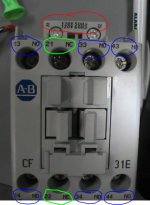hashmi.mohammad
Member
Master Control Relay vs. E-Stop vs. Motor Control Relay
Good morning,
I'm trying to understand the purpose of the Master Control Relay vs. The E-stop vs. Motor Control Relay with regards to the safety standards in the US. I've attached a picture of the MCR I want to use. Below is a scenario I made, and I want to see if this entire setup is considered "safe" according to whoever in the real world would come to a plant / factory and check for these things, specifically in the USA.
/* Scenario Start */
From my understanding, you would take your 120 V coming into a panel, and first put it through a fuse.
Then, you take the wire out of the fuse and place it through an E-stop push button. From there you would go to empty terminals and also to a power supply to get 24 V.
Now, lets say you have motion coming from your PLC, like a basic servo drive and a pump (both single phase 120V). You would take your two separate outputs from your PLC that enable the motor and pump and go through two separate fuses. Then these wires go through the red circled terminals into A1 and out of A2 on the Motor CR (so you have one Motor CR for motor and one for pump). Now your Motor CRs are energized. You would not go through overload protection for the motor or pump, since you already have a fuse. You can for redundancy in safety only.
Now you take 120 V from one of your empty terminals and go through another fuse and go into one of the blue contacts on the Motor CR. So one wire rated @ 120V for the motor, and one wire rated @ 120V for the pump.
If the motor and/or pump was 3 phase, you would place each phase into it's own blue terminal. If motor / pump was 3 phase, you would include overload protection.
In the PLC Logic, you would write logic to turn the motor off when the E-stop is hit; and you would prevent it from coming on when you reset the E-stop to prevent too much voltage being drawn from the power supply at start up, similar to the 2nd picture attached. Your PLC would also lose power when the E-stop is hit, but when it starts back up, the motor will not start due to the logic written. /* Scenario End */
So I didn't use a Master Control Relay, only a motor control control relay and an e-stop for safety. I was not sure how to incorporate the Master Control Relay and exactly what function it serves, but If you could rate the safety of this according to the most up-to-date standard specifically in the US, and what else this panel needs for safety improvement, that would be excellent, thanks.


Good morning,
I'm trying to understand the purpose of the Master Control Relay vs. The E-stop vs. Motor Control Relay with regards to the safety standards in the US. I've attached a picture of the MCR I want to use. Below is a scenario I made, and I want to see if this entire setup is considered "safe" according to whoever in the real world would come to a plant / factory and check for these things, specifically in the USA.
/* Scenario Start */
From my understanding, you would take your 120 V coming into a panel, and first put it through a fuse.
Then, you take the wire out of the fuse and place it through an E-stop push button. From there you would go to empty terminals and also to a power supply to get 24 V.
Now, lets say you have motion coming from your PLC, like a basic servo drive and a pump (both single phase 120V). You would take your two separate outputs from your PLC that enable the motor and pump and go through two separate fuses. Then these wires go through the red circled terminals into A1 and out of A2 on the Motor CR (so you have one Motor CR for motor and one for pump). Now your Motor CRs are energized. You would not go through overload protection for the motor or pump, since you already have a fuse. You can for redundancy in safety only.
Now you take 120 V from one of your empty terminals and go through another fuse and go into one of the blue contacts on the Motor CR. So one wire rated @ 120V for the motor, and one wire rated @ 120V for the pump.
If the motor and/or pump was 3 phase, you would place each phase into it's own blue terminal. If motor / pump was 3 phase, you would include overload protection.
In the PLC Logic, you would write logic to turn the motor off when the E-stop is hit; and you would prevent it from coming on when you reset the E-stop to prevent too much voltage being drawn from the power supply at start up, similar to the 2nd picture attached. Your PLC would also lose power when the E-stop is hit, but when it starts back up, the motor will not start due to the logic written. /* Scenario End */
So I didn't use a Master Control Relay, only a motor control control relay and an e-stop for safety. I was not sure how to incorporate the Master Control Relay and exactly what function it serves, but If you could rate the safety of this according to the most up-to-date standard specifically in the US, and what else this panel needs for safety improvement, that would be excellent, thanks.





